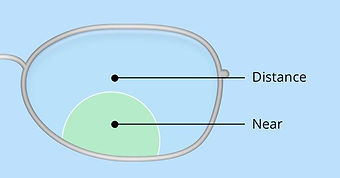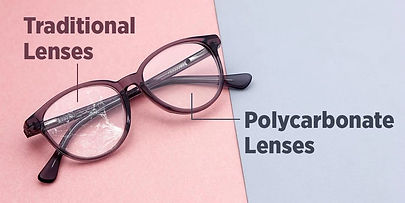TYPES OF LENSES
CR 39 Lenses
CR 39 (Columbia Resin) is a thermosetting plastic lens commonly used for eyeglasses.
Refractive index 1.5
The material is with better impact resistance and high transparency
Advantages:
High Impact resistance
Light in weight
Resistance to chemicals, solvents, heat, and temperature fluctuations
Suitable for single vision, bifocal, progressive lenses
Available with Anti-Scratch coating, HMC/ARC (anti-reflection coating), Photochromic glasses, Tinted lenses
Less expensive
Disadvantages:
Increase in thickness with high powers (not recommended for high powers)
Surface abrasions (better with Scratch resistance coating)
Bifocal Lenses:
Bifocal lenses are lenses with lines separating two different prescriptions (Distance Vision and Near Vision)
There is a presence of a distance lens at the top and the lower part has a lens that can be used to view the objects placed nearby.
Bifocal lenses are used by them and are prescribed to people above the age of 40 years who have natural degradation of their vision due to their aging process.
There are different types of bifocal lenses present but they provide the same user which is the lower part of the lens is used to view the nearby objects or to do work related to reading and writing while the upper part of the lens is used to view the objects placed at a faraway distance or to do an activity like driving.
Advantages:
Can use same glasses for distance and near vision
Inexpensive than Progressive lenses
They can be mounted on any frame and give a wide range of frames to choose from
Can Add coatings on the lens and Photochromic options are available
Disadvantages:
The bifocal lens does not have an intermediate lens and can be a problem for those who work on computers. (Progressive Lenses can be an option to replace Bifocal lenses)
Progressive Lenses:
progressive lenses are no-line bifocal lenses where there is a slow transition of the power from the upper part of the lens to the lower part of the lens. Such lenses are made in a particular way that no distinction between the two different types of lenses is visible.
Advantages:
Can use same glasses for distance, intermediate, and near vision
very inconvenient to keep changing glasses to view different distances
No distracting bi-focal or multi-focal line.
Modern youthful appearance
Disadvantages:
Little expensive than Bifocal and Single vision lenses
Takes time to get used to
The absence of the line means that there is no way to determine where to look for clear vision.
Therefore, due to the use of the learning curve, it may take a lot of time to figure out the correct way to look through the lens.
Temporary vision distortions
Adjustment problems initially
High Index Lenses:
High-index lenses are eyeglass lenses that are designed to be thinner and lighter than regular lenses.
They are generally recommended for people who have significantly high refractive errors and strong prescriptions for near-sightedness, farsightedness, or astigmatism.
While both regular and high index lenses function in the same way, high index lenses are designed to bend light more efficiently — leading to thinner and lighter lenses.
Regular CR39 lenses have a refractive index of 1.50 (adequate for correcting mild to moderate refractive errors)
High-index lenses have a refractive index above 1.50— ranging from 1.53 to 1.74. (1.61, 1.67,1.74)
1.61 Index Lenses 30% Thinner than CR39 lenses
1.67 Index Lenses 50% Thinner than CR39 lenses
1.74 Index lenses 60% Thinner than CR39 lenses
Advantages:
contain less material than regular lenses and are therefore lighter and more comfortable
Generally, scratch-resistant
Comes with all necessary costings (Hydrophobic, anti-glare, UV protected)
The unique aspheric design facilitates a flatter lens curvature, leading to reduced magnification and improved visual performance.
Disadvantages:
Expensive than regular lenses
More reflectivity (recommended to use with anti-reflection coatings)
Polycarbonate Lenses:
The most impact resistant of all lens materials is polycarbonate
Refractive index 1.59
Children, athletes, anyone working at a job or hobby where they might get hit in the face and need safety glasses, people with only one eye, those who fall a lot, are natural candidates for polycarbonate lenses. If safety is a prime concern, choose polycarbonate lenses.
Advantages:
Polycarbonate has four to five times the impact resistance of glass or plastic.
Lightest lens material made.
Polycarbonate lenses naturally protect against ultra-violet light, at no additional charge.
Polycarbonate lenses come with a scratch-resistant coating

.jpeg)
.jpeg)
.jpeg)
.jpeg)
